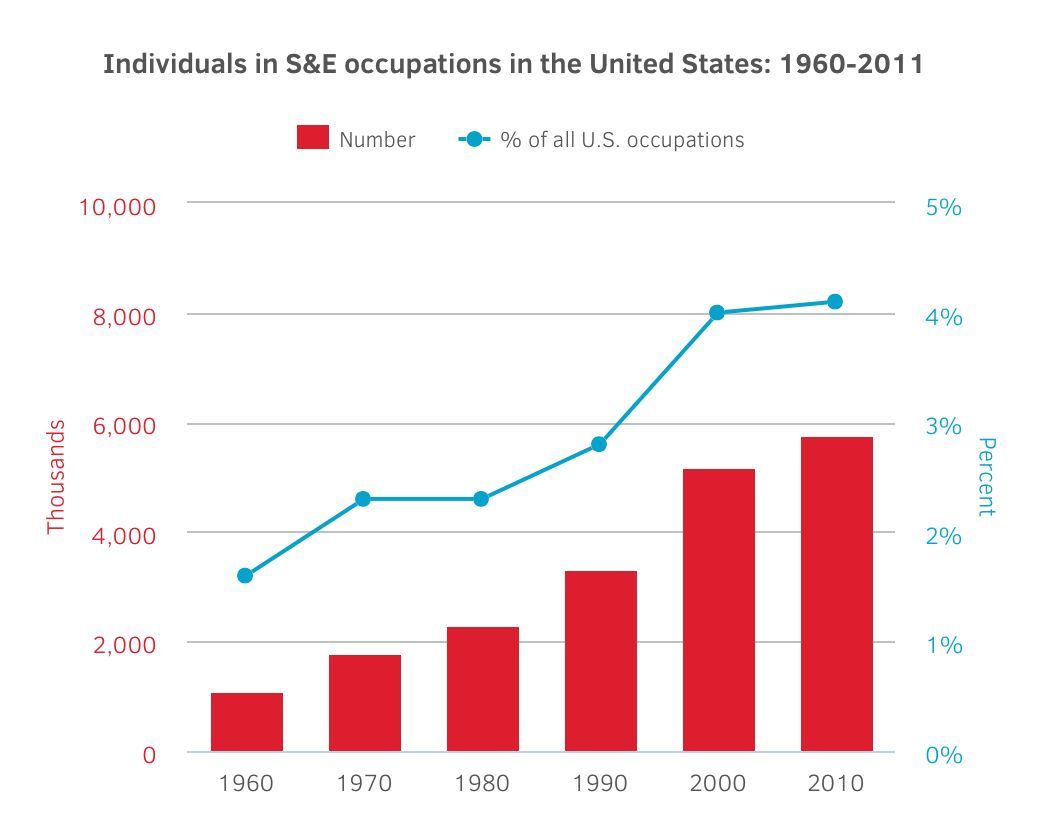Breaking Boundaries: STEM and Beyond
Crafting Careers Beyond Convention with STEM

In today's fast-paced world, the career landscape is undergoing a seismic shift. Gone are the days when a standard STEM (Science, Technology, Engineering, and Mathematics) education was the sole ticket to success. In this exploration, we'll unravel the evolution of STEM education, celebrate the power of a multidisciplinary approach, and illuminate the exciting frontier of non-traditional careers
blending STEM with creative flair.
Growth of STEM
The National Science Foundation (NSF) has done research on science and engineering jobs and their importance in the job market. According to the NSF:
- The number of workers in S&E occupations grew from about 1.1 million in 1960 to about 5.8 million in 2011. This represents an average annual rate of 3.3%, greater than the 1.5% growth rate for the total workforce.
- As a proportion of all employment, S&E occupational employment grew from 1.6% in 1960 to 4.1% in 2011.
- During and after the 2007–09 recession, employment in S&E or S&E related jobs was generally more resilient than was overall employment.

Expanding the Horizon of STEM Education
Let's challenge the traditional view of STEM education! It's not just about equations and formulas; it's about embracing a kaleidoscope of skills. Think design, digital media, and creative problem-solving. This broader perspective recognizes that innovation thrives at the intersection of science, technology, engineering, mathematics, and the arts. It's where creativity meets logic to spark groundbreaking ideas.
Expanding the horizon of STEM education with business involvement can enrich learning experiences and better prepare students for the demands of the modern workforce. Here are a few ways to achieve this:
- Industry Partnerships and Internships: Collaborate with businesses to provide students with hands-on learning opportunities through internships, co-op programs, or industry-sponsored projects. By working alongside professionals in real-world settings, students gain practical experience, develop industry-relevant skills, and gain insight into the inner workings of businesses. Additionally, businesses can contribute to curriculum development, ensuring that educational programs align with industry needs and emerging trends.
- Guest Lectures and Workshops: Invite industry experts to deliver guest lectures, conduct workshops, or participate in panel discussions. These sessions expose students to diverse perspectives, current industry practices, and emerging technologies. Moreover, guest speakers can share insights into career pathways, industry trends, and the skills required to succeed in the field, inspiring students to pursue STEM-related careers.
- Project-Based Learning: Engage students in project-based learning experiences that simulate real-world challenges faced by businesses. Collaborate with industry partners to identify relevant projects that require interdisciplinary skills and problem-solving abilities. By working on authentic projects, students develop critical thinking, communication, and teamwork skills while gaining practical experience in applying STEM concepts to solve complex problems.
- Entrepreneurship and Innovation Programs: Offer entrepreneurship and innovation programs that encourage students to develop entrepreneurial mindsets and pursue STEM-related ventures. Partner with businesses to provide mentorship, funding opportunities, and access to resources for student-led startups. By fostering an entrepreneurial culture, educational institutions can empower students to innovate, take risks, and create impactful solutions that address real-world needs.
- Professional Development Opportunities: Provide professional development opportunities for educators to stay in the know of industry trends, pedagogical best practices, and emerging technologies. Collaborate with businesses to offer workshops, training sessions, and certification programs for educators, equipping them with the knowledge and skills needed to deliver high-quality STEM education. Additionally, businesses can sponsor scholarships, grants, or fellowships for educators to pursue advanced training or research in STEM fields.
By infusing arts and digital skills into STEM curricula, you’re not just teaching; you’re cultivating the next generation of innovators. Picture students harnessing design thinking principles to tackle real-world challenges with imagination and finesse. It's about empowering them to think outside the box and communicate complex concepts in compelling ways.
The Power of Multidisciplinary Learning
Let's break down the barriers between disciplines! Multidisciplinary learning is the secret sauce for fostering adaptability and resilience. It's where students venture beyond the confines of traditional silos and explore the fertile ground where STEM and creativity converge. Here, they learn to connect the dots between seemingly unrelated fields, unleashing a torrent of innovative solutions.
Imagine a classroom buzzing with collaboration, where budding engineers collaborate with artists to prototype groundbreaking inventions. It's about nurturing versatile skill sets that transcend boundaries and preparing students to thrive in a world where innovation knows no limits.
Here are three ways to cultivate multidisciplinary learning.
- Fostering Creativity and Innovation: Multidisciplinary learning breaks down the barriers between traditional subjects, encouraging students to explore connections and intersections between different fields. By engaging in projects that integrate elements of science, technology, engineering, mathematics, and the arts, students develop a more holistic understanding of complex problems. This approach fosters creativity by allowing students to draw on diverse perspectives and tools to develop innovative solutions.
- Cultivating Critical Thinking and Problem-Solving Skills: Multidisciplinary learning challenges students to think critically and approach problems from multiple angles. By working across disciplines, students learn to analyze problems, synthesize information, and develop creative solutions. This process cultivates problem-solving skills that are essential for success in the 21st-century workforce, where complex problems often require interdisciplinary approaches.
- Preparing for Diverse Career Pathways: In today's interconnected world, the ability to work across disciplines is increasingly valuable. Multidisciplinary learning equips students with versatile skills that are applicable across a wide range of industries and professions. Whether pursuing a career in technology, healthcare, design, or entrepreneurship, students who engage in multidisciplinary learning are better prepared to navigate diverse career pathways and adapt to evolving job market demands.
Navigating Non-Traditional Career Paths
Welcome to the brave new world of non-traditional careers! Digital marketing, graphic design, data visualization – these aren't just jobs; they're opportunities for creative expression in the digital age. Here, professionals blend technical prowess with artistic flair to craft compelling narratives, captivating visuals, and immersive experiences.
Picture a data scientist transforming raw numbers into captivating visual stories that resonate with audiences. It's about leveraging the power of data to drive decision-making and spark meaningful conversations. In these dynamic fields, versatility is key, and innovation knows no bounds.
Navigating non-traditional career paths from a business perspective requires forward-thinking strategies to attract, retain, and develop talent with diverse skill sets. Here are ways businesses can approach this:
- Flexible Talent Acquisition Strategies: Recognize that traditional hiring criteria may not fully capture the potential of candidates with non-traditional backgrounds. Implement flexible talent acquisition strategies that prioritize skills, competencies, and potential over specific educational or professional backgrounds. Consider alternative recruitment channels, such as hackathons, portfolio reviews, or skills-based assessments, to identify candidates who possess the blend of technical expertise and creative skills required for non-traditional roles.
- Customized Career Development Paths: Design customized career development paths that accommodate the diverse interests and aspirations of employees pursuing non-traditional career paths. Offer cross-training opportunities, job rotations, and skill-building programs that enable employees to explore different roles, develop new skills, and pivot into non-traditional career paths within the organization. Provide mentorship, coaching, and networking opportunities to support employees in navigating their career journeys and overcoming challenges along the way.
- Cultivating a Culture of Innovation and Inclusion: Foster a culture of innovation and inclusion that values diversity of thought, encourages experimentation, and celebrates unconventional approaches. Create interdisciplinary teams that bring together individuals with diverse backgrounds, perspectives, and skill sets to collaborate on projects and solve complex problems. Encourage employees to share their unique experiences, insights, and ideas openly, fostering a culture of psychological safety where everyone feels empowered to contribute and innovate.
By embracing flexible talent acquisition strategies, offering customized career development paths, and cultivating a culture of innovation and inclusion, businesses can navigate non-traditional career paths effectively and harness the full potential of their diverse talent pool.
Embracing Diversity in Talent Acquisition
In today's hyper-competitive landscape, businesses must rethink their talent strategies. It's not just about recruiting STEM wizards; it's about embracing diversity in all its forms. By championing a broader definition of STEM and supporting educational initiatives that foster interdisciplinary learning, organizations can tap into a rich pool of talent primed for success.
Imagine a workplace where diverse perspectives fuel innovation and collaboration. It's about creating an environment where everyone feels valued and empowered to unleash their full potential. By embracing diversity, businesses can unlock a world of possibilities and chart a course towards a brighter future.
Embracing diversity in talent acquisition is essential for businesses to build inclusive workplaces that reflect the rich tapestry of society. Here are three ways to achieve this:
- Implementing Blind Hiring Practices : Adopt blind hiring practices to mitigate unconscious bias and promote diversity in the recruitment process. Remove identifying information such as names, genders, and ethnicities from resumes and applications to ensure that candidates are evaluated based solely on their skills, qualifications, and experiences. Use structured interviews, skills assessments, and objective criteria to assess candidates' potential fit for the role, focusing on their abilities rather than personal characteristics.
- Expanding Recruitment Channels: Broaden recruitment channels to reach a diverse pool of candidates from different backgrounds and communities. Partner with diversity-focused organizations, professional associations, and educational institutions to attract talent from underrepresented groups. Leverage social media, online job boards, and community outreach programs to connect with diverse candidates and promote job opportunities. By casting a wider net, businesses can tap into diverse talent pipelines and ensure that their workforce reflects the diversity of the communities they serve.
- Implementing Diversity Training for Hiring Teams: Provide diversity training for hiring teams to raise awareness of unconscious bias, foster inclusive hiring practices, and promote diversity and equity in talent acquisition. Offer workshops, seminars, and online courses that educate hiring managers and recruiters on the importance of diversity, equity, and inclusion in the workplace. Equip them with tools, strategies, and best practices for mitigating bias, fostering diverse candidate pools, and creating inclusive hiring processes. By empowering hiring teams to recognize and address bias, businesses can build more diverse and inclusive teams that drive innovation and success.
As we stand on the cusp of a new era, the possibilities are limitless. By reimagining STEM education and embracing the synergy between science, technology, engineering, mathematics, and the arts, we're shaping a future where creativity and innovation reign supreme. It's about breaking down barriers, fostering collaboration, and celebrating the diversity of thought.
In this ever-evolving landscape, success isn't just about what you know; it's about how you think. By nurturing a culture of lifelong learning, creativity, and collaboration, we're empowering the next generation to blaze their own trails and leave an indelible mark on the world. So, let's roll up our sleeves, embrace the unknown, and embark on a journey of discovery together. The future awaits – let's make it extraordinary.
